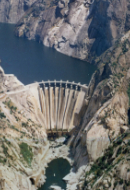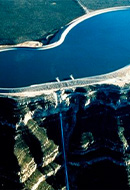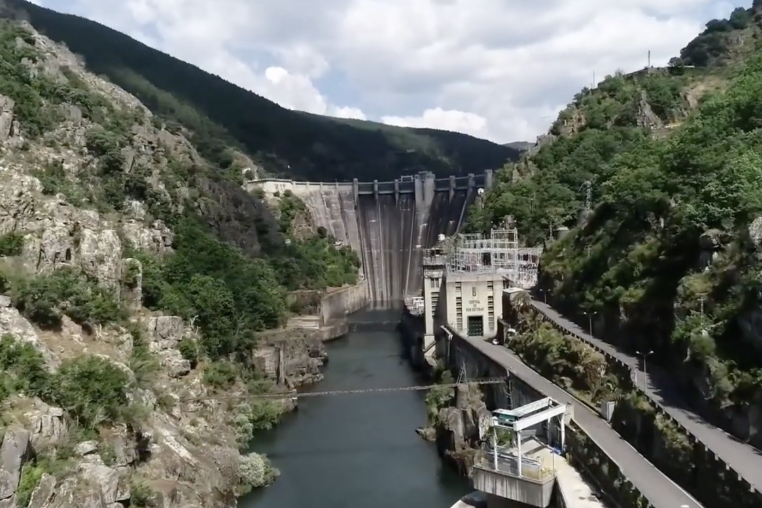San Esteban hydroelectric plant
San Estevo, the largest hydroelectric complex in Galicia
Hydroelectric power Operating plants
The completion of the San Esteban II hydroelectric plant in 2013 made the San Esteban (San Estevo) plant the largest hydroelectric complex in Galicia, with a total installed capacity of 451 MW. Located in the Sil river basin, the facility is a pioneer in the region for producing hydroelectric power equivalent to the average annual consumption of more than 600,000 people, almost twice the population of the province of Ourense.

San Esteban Hydroelectric power plant




Since the 1950s, the San Esteban hydroelectric complex (Santo Estevo, in Galician) has been one of the Iberdrola group's main commitments to hydroelectric power in Spain. With the recent enlargement of the dam, culminating in the San Esteban II project, the facility located in the basin of the river Sil, belonging to the municipality of Nogueira de Ramuín (Ourense), became the largest generator of renewable electricity in Galicia. Its total installed capacity currently stands at 451 MW.
This infrastructure has two power plants: San Esteban I, which has been in operation for more than half a century with a capacity of 263 MW, and San Esteban II, in operation since 2013 after an engineering work in record time that added another 188 MW to its generating power. With these two facilities in operation, the complex is capable of producing more than 1,000 GWh per year, enough to meet the energy needs of more than 600,000 people, which represents almost twice the population of the province of Ourense.
The reservoir's privileged location gives it great potential in terms of natural resources. Due to the high average rainfall in the region, one of the wettest in the country, the San Esteban complex makes the best use of rainwater to generate clean, renewable energy for more than 320,000 families.
The start of the San Esteban hydroelectric power plant
Iberdrola's commitment to hydroelectric power in Galicia began with the San Esteban project in 1945, when the first accesses to the land where the plant is currently located began to be built in the canyon of the river Sil. Nearly 2,000 people were involved in the construction of the hydroelectric complex, which was completed years later, in 1956, representing one of the most important milestones in the history of the group in Spain as it was the largest installed capacity facility of its kind in Europe at that time.
To carry out this important project of the San Esteban waterfall, it was necessary to use around 150,000 tonnes of cement and another 10,000 tonnes of steel, which resulted in the construction of a dam on an area of difficult relief. From its first years of service, the electrical exploitation of the river Sil made a significant contribution to the production of energy for the country's industrial life.
The extraordinary engineering work used to build the San Esteban dam, in addition to the innovative techniques applied during the years of its construction, make it one of the group's major operational hydraulic facilities in Spain, along with others such as the Aldeadávila, Cortes - La Muela and Ricobayo power stations. Its concrete "gravity arch" type dam is 115 metres high, has a crest length of 295 metres and six spillways, which means that it has a reservoir capacity of 213 cubic hectometres on a surface area of 737 hectares.
The extension of the complex with San Esteban II
Over the years, it was decided to expand the original plant to increase its generation capacity, optimising the existing infrastructures (dam, reservoir and evacuation lines). This is when, in 2008, work began on the San Esteban II project. Nestled in the canyons of the river Sil, the construction of the new power plant was carried out in a cavern (minimising the environmental impact) located 100 metres deep, completely underground, not visible from the outside, which allows the privileged ecosystem of the Ribeira Sacra to be maintained.
During the years of construction of the most recent plant at the San Esteban complex, the electricity company made a total investment of €127 million, in addition to creating close to 300 jobs, which was a huge boost for industry in Galicia. At the inauguration ceremony of San Esteban II held in May 2013, Iberdrola's chairman, Ignacio Sánchez Galán, highlighted the efforts to build the largest hydroelectric complex in the region, with its 451 MW of capacity.
The San Esteban hydroelectric power plant from a drone's eye view (Spanish version).
In January 2017, the group completed the expansion of San Esteban with the commissioning of a new hydroelectric plant, San Pedro II, which acts as a counter-dam to San Esteban to modulate the flow of the river Sil.
The San Esteban hydroelectric plant represents just one of Iberdrola's various renewable projects in Galicia. The electricity company currently manages more than 2,200 MW of clean production in the region, a figure that makes it one of the autonomous communities that generates the most green megawatts installed by the company in Spain.
Of particular note is the group's firm commitment to energy from hydroelectric plants in Galicia, responsible for more than half (1,582 MW) of the total renewable capacity generated in Galicia. Iberdrola's long-standing position as one of the major hydroelectric producers in the region has served to boost the local business fabric, generating thousands of jobs that activate the local economy.
Iberdrola, world leader in renewable energies
At Iberdrola, we dare committed to renewable energy more than two decades ago as a fundamental pillar on which to build our safe, clean and competitive business model. Thanks to this vision, we are today world leaders in renewables, reaching 44,478 MW of clean energy in operation at the end of 2024.
This commitment is reflected in our Strategic Plan, in which we will allocate €15.5bn gross to renewables. More than half of this amount is focused on offshore wind in the US, UK, France and Germany; 28% on onshore wind and 18% on solar.

What is hydroelectric energy
Find out how hydroelectric power plants work.

Types of dams
There are different types of dams depending on their materials or mechanisms.

Hydropower terms
The 10 most relevant concepts in hydropower.

Pumped-storage hydropower plants
Do you know what pumped-storage hydropower stations are used for?





